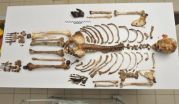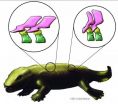(Press-News.org) A new method of establishing hair and eye colour from modern forensic samples can also be used to identify details from ancient human remains, finds a new study published in BioMed Central's open access journal Investigative Genetics. The HIrisPlex DNA analysis system was able to reconstruct hair and eye colour from teeth up to 800 years old, including the Polish General Wladyslaw Sikorski (1881 to 1943) confirming his blue eyes and blond hair.
A team of researchers from Poland and the Netherlands, who recently developed the HIrisPlex system for forensic analysis, have now shown that this system is sufficiently robust to successfully work on older and more degraded samples from human remains such as teeth and bones. The system looks at 24 DNA polymorphisms (naturally occurring variations) which can be used to predict eye and hair colour.
Dr Wojciech Branicki, from the Institute of Forensic Research and Jagielonian University, Kraków, who led this study together with Prof Manfred Kayser, from the Erasmus University Rotterdam, explained, "This system can be used to solve historical controversies where colour photographs or other records are missing. HIrisPlex was able to confirm that General Wladyslaw Sikorski, who died in a plane crash in 1943, had the blue eyes and blond hair present in portraits painted years after his death. Some of our samples were from unknown inmates of a World War II prison. In these cases HIrisPlex helped to put physical features to the other DNA evidence."
For medieval samples, where DNA is even more degraded, this system was still able to predict eye and hair colour (for the most degraded DNA samples eye colour alone), identifying one mysterious woman buried in the crypt of the Benedictine Abbey in Tyniec near Kraków, sometime during the 12th-14th centuries, as having dark blond/brown hair and brown eyes.
INFORMATION:
Media Contact
Dr Hilary Glover
Scientific Press Officer, BioMed Central
Tel: +44 (0) 20 3192 2370
Mob: +44 (0) 778 698 1967
Email: hilary.glover@biomedcentral.com
Notes
1. Bona fide colour: DNA prediction of human eye and hair colour from ancient and contemporary skeletal remains
Jolanta Draus-Barini, Susan Walsh, Ewelina Pospiech, Tomasz Kupiec, Henryk Glab, Wojciech Branicki and Manfred Kayser
Investigative Genetics (in press)
Please name the journal in any story you write. If you are writing for the web, please link to the article. All articles are available free of charge, according to BioMed Central's open access policy.
Please credit pictures to Arkadiusz Wrebiak, Wojciech Branicki and Manfred Kayser
Article citation and URL available on request on the day of publication.
2. Investigative Genetics is a peer-reviewed, open access, online journal, which publishes articles on the development and application of molecular genetics in a wide range of science disciplines with societal relevance. These include forensic issues and legal medicine, evolutionary, anthropological and historical studies, as well as epidemiology and biosafety.
3. BioMed Central is an STM (Science, Technology and Medicine) publisher which has pioneered the open access publishing model. All peer-reviewed research articles published by BioMed Central are made immediately and freely accessible online, and are licensed to allow redistribution and reuse. BioMed Central is part of Springer Science+Business Media, a leading global publisher in the STM sector. @BioMedCentral
What did our ancestors look like?
2013-01-14
ELSE PRESS RELEASES FROM THIS DATE:
New study reveals gas that triggers ozone destruction
2013-01-14
Scientists at the Universities of York and Leeds have made a significant discovery about the cause of the destruction of ozone over oceans.
They have established that the majority of ozone-depleting iodine oxide observed over the remote ocean comes from a previously unknown marine source.
The research team found that the principal source of iodine oxide can be explained by emissions of hypoiodous acid (HOI) – a gas not yet considered as being released from the ocean – along with a contribution from molecular iodine (I2).
Since the 1970s when methyl iodide (CH3I) was ...
Graphene plasmonics beats the drug cheats
2013-01-14
Writing in Nature Materials, the scientists, working with colleagues from Aix-Marseille University, have created a device which potentially can see one molecule though a simple optical system and can analyse its components within minutes. This uses plasmonics – the study of vibrations of electrons in different materials.
The breakthrough could allow for rapid and more accurate drug testing for professional athletes as it could detect the presence of even trace amounts of a substance.
It could also be used at airports or other high-security locations to prevent would-be ...
Scientists reassemble the backbone of life with a particle acceleratorynchrotron X-rays
2013-01-14
This press release is available in French and German.
Jointly issued with STFC and the Royal Veterinary College London.
Scientists have been able to reconstruct, for the first time, the intricate three-dimensional structure of the backbone of early tetrapods, the earliest four-legged animals. High-energy X-rays and a new data extraction protocol allowed the researchers to reconstruct the backbones of the 360 million year old fossils in exceptional detail and shed new light on how the first vertebrates moved from water onto land. The results are published 13 January ...
Foot soldiers of the immune system
2013-01-14
Researchers at McGill University and the Research Center for Molecular Medicine (CeMM) of the Austrian Academy of Sciences have discovered the molecular blueprint behind the IFIT protein. This key protein enables the human immune system to detect viruses and prevent infection by acting as foot soldiers guarding the body against infection. They recognize foreign viral ribonucleic acid (RNA) produced by the virus and act as defender molecules by potentially latching onto the genome of the virus and preventing it from making copies of itself, blocking infection. The findings ...
Smoking intensity and cancer markers predict seriousness of bladder cancer
2013-01-14
Smoking not only causes bladder cancer—it also affects its course, in that people who smoke more have greater likelihood of developing more aggressive and deadly disease. That is one of the conclusions of a new study published early online in CANCER, a peer-reviewed journal of the American Cancer Society. The study also found that a panel of bladder cancer markers can predict which particular cases are at the highest risk for a fatal outcome.
Researchers have known that smoking is one of the most common causes of bladder cancer, but they've wondered whether it also affects ...
30 percent of teen girls report meeting offline with someone they met online
2013-01-14
A new study highlights the risk that female teenagers face when they go online – a risk heightened for teen girls who have been victims of abuse or neglect.
The study, published in the eFirst pages of the journal Pediatrics, shows that 30 percent of teenagers reported having offline meetings with people they have met on the Internet and whose identity had not been fully confirmed prior to the meeting.
"These meetings may have been benign, but for an adolescent girl to do it is dangerous," says Jennie Noll, PhD, a psychologist at Cincinnati Children's Hospital Medical ...
Less reaction to DTaP vaccine given in kids' thighs than arms
2013-01-14
SEATTLE—Children age 12 to 35 months who receive DTaP vaccine in their thigh muscle rather than their arm are around half as likely to be brought in for medical attention for an injection-site reaction. So says a new study of 1.4 million children at Group Health and seven other Vaccine Safety Datalink (VSD) centers across the country, e-published on January 14 in Pediatrics.
"These local reactions are the most common side effect of vaccinations," said study leader Lisa A. Jackson, MD, MPH, a senior investigator at Group Health Research Institute. "But we have known relatively ...
Alternative medicine use high amoung children with chronic conditions: UAlberta medical research
2013-01-14
Children who regularly see specialists for chronic medical conditions are also using complementary medicine at a high rate, demonstrates recently published research from the University of Alberta and the University of Ottawa.
About 71 per cent of pediatric patients attending various specialty clinics at the Stollery Children's Hospital in Edmonton used alternative medicine, while the rate of use at the Children's Hospital of Eastern Ontario in Ottawa was 42 per cent. Nearly 20 per cent of the families who took part in the study said they never told their physician or ...
Federal Safe Routes to School program reduces child injuries by more than 40 percent in New York City
2013-01-14
The national Safe Routes to School (SRTS) program was funded by Congress in 2005 in an effort to create safe environments for American children to walk or bike to school. Has the program been effective? In New York City, most definitely, according to a new study conducted at Columbia University's Mailman School of Public Health that evaluated the program here. Researchers found that the annual rate of injury to school-age pedestrians ages 5-19 fell 44% during the peak times for walking to school, in neighborhoods where the program was implemented. Significantly, the injury ...
Research suggests molecular 'switch' may play role in tumor suppression
2013-01-14
BLOOMINGTON, Ind. -- Newly published research by Indiana University structural biologist Joel Ybe and colleagues identifies a "topology switch" in the protein clathrin, the function of which may shed light on molecular processes involved in tumor suppression.
The paper, available in and featured on the front cover of the Jan. 16, 2013, issue of FEBS Letters, a journal of the Federation of European Biochemical Societies, could broaden scientists' understanding of the importance of clathrin and potentially lead to new strategies for controlling cancer.
"This is a totally ...


